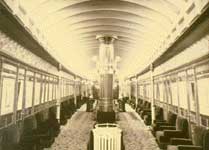Niagara (ship)
|
||||||||||||||||
|
||||||||||||||||
|
||||||||||||||||
The Niagara was a paddle steamer of the US-American shipping company Collingwood Line put into service in 1846 , which burned down on September 24, 1856 in an unexplained fire and sank on Lake Michigan . Of the approximately 175 passengers and crew members, between 60 and 70 were killed. It is one of the worst transportation accidents in the history of the US state of Wisconsin .
The ship
The 1009 GRT paddle steamer Niagara was built in 1846 at the Bidwell & Banta shipyard in Buffalo , one of the largest shipyards in New York at the time . He was a so-called "palace steamer" ("palace steamer"), as a certain group of comfortable steamships was called, which transported passengers and cargo on the Great Lakes between 1844 and 1857 . They were considered the pinnacle of passenger traffic on the Great Lakes and a link between the railway lines in the Midwest . The Niagara was the second of a total of 25 Palace Steamers built.
The Niagara was operated by the shipping company Collingwood Line, which was part of the New York and Erie Railroad founded in 1832, which later became the Erie Railroad . The ship was 70.1 meters long, 10.36 meters wide and had a side height of 4.26 meters. The wooden hull was painted white. The Niagara was powered by a steam engine that worked on two side paddle wheels.
The misfortune
On Monday, September 22, 1856 at 14.00 which ran Niagara in Collingwood in the Canadian province of Ontario to a crossing of the Lake Michigan to Chicago multi-stop from. She served on this voyage as a temporary replacement for Keystone State , which had been damaged in a storm and had to be repaired.
Captain Frederick S. Miller was in command. On September 23, the ship ran into Sheboygan (US state Wisconsin ), where about 25 passengers disembarked. In addition to 105 tons of cargo and 21 horses , between 150 and 175 passengers were on board on the further journey; the exact numbers differ due to the lost passenger list and different reports about the accident. On Tuesday, September 23 at 12:00 noon, Mackanic was reached, where at least six passengers boarded. This was followed by stops in Two Rivers and Manitowoc.
At around 4 p.m. on September 24, just as Port Washington was coming into view, clouds of smoke were noticed by passengers below deck, which appeared to be coming from the area of the engine room . Long flames followed them. The passengers immediately gave the alarm. The fire spread quickly, engulfing the steamer, which was between four and five miles from shore, in flames and smoke. Captain Miller turned and headed for the bank , wanting to run the Niagara aground in shallow waters. The strong wind fanned the flames even more. Attempts to stop the fire using fire hoses failed. Shortly afterwards, the steam engines and the paddle wheels stopped.
The passengers panicked and stormed the lifeboats , all but one of which capsized. Many people jumped off the ship to escape the fire. Mothers threw their children overboard and jumped after them. According to contemporary reports, the water was too cold for a person to survive in it for long. According to some reports, there were no life jackets on board , so those who jumped overboard drowned. Cabin doors were smashed with axes and thrown overboard along with everything that was buoyant to be used as a swimming aid. Ropes were thrown over the side of the ship, and men and women clung to it until the flames reached them.
Several ships that were in the immediate vicinity came to the scene of the accident and took in the survivors, including the steamers Traveler and Illinois and the schooners Marble and Mary Grover . A lifeboat from Port Washington also came to the rescue and saved 20 people. Between 60 and 70 people, mostly passengers, died in the fire or drowned in Lake Michigan. Captain Miller and all but two of the crew survived. Among the casualties of the 57-year-old politician was John B. Macy , a former congressman of the Democrats .
When questioned later, Captain Miller insisted that the fire could not have broken out in the engine room as he considered it to be fire-safe. He suspected that flammable goods belonging to the cargo had ignited. Newspapers also reported suspicion of an incendiary bomb . The exact cause of the fire has never been fully established. The accident caused an uproar in the local media. It is one of the worst transportation accidents in Wisconsin's history.
The wreck of the Niagara is 17 meters deep about 1.6 kilometers from the small town of Belgium at position 43 ° 29 ′ 19 ″ N , 87 ° 46 ′ 30 ″ W . 1996, it was in the cultural heritage list National Register of Historic Places added (registration number 96001456).


